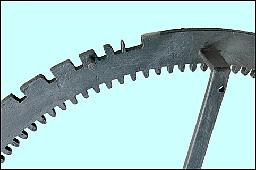
Chiming machine and an interesting sequence
The chiming machine was at the time of the making of the clock
located remotely from the main machine. It was in the tower, close to
the bell. It may have been that a remnant of the old machine of the
town hall tower was used for this. Not until 1629 or 1659 it was lifted
down and attached to the going main machine and, probably, considerably
modified. It is probably at that time that the remarkable solution of
duplicate locking wheel was created;
 it uses a “mathematical trifle”,
which was named Šindel’s sequence after the supposed inventor of the
astronomical clock and vicechancellor of the Charles University. The
duplication of locking wheels was also rarely used for other tower
clocks in Italy. Today, the Prague Astronomical Clock is probably the
only one where this system is still functional.
it uses a “mathematical trifle”,
which was named Šindel’s sequence after the supposed inventor of the
astronomical clock and vicechancellor of the Charles University. The
duplication of locking wheels was also rarely used for other tower
clocks in Italy. Today, the Prague Astronomical Clock is probably the
only one where this system is still functional.
The figure on the right shows the main locking wheel with an internal tooth system of 120 teeth. The pinion (not visible) with six vessels rotates in the same way as the small locking wheel. The locking lever locks into both wheels. The large wheel makes one turn a day, the small one then 20 turns. Chiming stops in the moment when the dents of both wheel meet.
Generally, one locking wheel is sufficient for the function of a chiming clock. After the chiming starts, the locking lever slides along the perimeter of the wheel until it falls into the dent. The length of the segment between the dents corresponds to the number of strokes. It works quite well for small clocks including e. g. Schwarzwald clock, where precision was not so important. With an astronomical clock, the situation is somewhat different. The chiming machine is constructed for chiming “around the clock”, i.e. for 24 hours. That means 300 strokes per day; (if you don't believe it, just calculate: one half of (1+24)*24). Considering the size of the locking wheel and the influence of various plays, inaccuracies and weather, it led to inaccurate chiming. The moment of the lockon of the locking lever would sometimes advance and the machine chimed one hour less.
The insertion of the second locking wheel brings enhanced accuracy assumed that the wheel is considerably smaller. But how to ensure that the far smaller wheel also counts 300 strokes per day? Mathematics must come to help and design a very sophisticated distribution of the teeth. Whereas the big wheel has 23 dents and segments for chiming of 2 to 24 hours (the dent for chiming of one hour is twofold, the wheel does not have a segment that would prevent the machine from stopping after the stroke), the small wheel has 6 dents with segments for chiming of 1, 2, 3, 4, 3 and 2 strokes. This sequence repeats 20 times a day; that means 15 x 20 = 300 strokes just as with the big wheel only. The arrangement of segments, as we will show further, allows gradual chiming of the sequence of 1 to 24 strokes. The small wheel, thanks to its faster rotation, allows higher precision of the stopping of the chiming machine at the right moment and the big wheel prevents it from stopping after an unfavourable segment of the small wheel.
Let us show this sequence in numbers:
| Big | 1 | 2 | 3 | 4 | 5 | 6 | 7 | 8 | 9 | 10 | 11 | ... | ||||||||||||||||
| Small | 1 | 2 | 3 | 4 | 3 | 2 | 1 | 2 | 3 | 4 | 3 | 2 | 1 | 2 | 3 | 4 | 3 | 2 | 1 | 2 | 3 | 4 | 3 | 2 | 1 | 2 | 3 | ... |
We see that the chiming of the 1st up to 4th hours is ensured identically by both wheels. When chiming the 5th hour, the small wheel would stop after only three strokes. The segment of the big wheel, however, prevents this. The dents will meet after 5 strokes. The locking lever locks according to the small wheel. All continues on in this way. When chiming the 6th hour, the segment of the big wheel prevents the locking lever from locking after the first and third stroke.
For the sequence 1, 2, 3, 4, 3, 2, 1, we can continue ad infinitum. Not every periodic sequence has this quality by far. We can find other sequences that can act as the Šindel’s sequence. On the other hand, this one is the most suitable for realization in a clock machine and is, in a way, also beautiful. We let mathematicians deal with the exact mathematical definition of the Šindel’s sequence. You can find it via the following link.
One more remark about the small chiming wheel: The wheel is, in terms of the order of segments, symmetrical. For this reason it did not matter how it was installed. However, one edge of the dent is always sharp and the other rounded. There is a good reason for the wheel to turn in the direction of the rounded edge. It is the declining edge that is decisive for the function of the locking lever. For quick locking of the chiming machine, is it necessary that this declining edge is, if possible, straight and that the lever locks quickly.
Text: Petr Král, photo: Stan. Marušák






